Today in Irish History, The Death of Bessie O’Brien, Dublin, 21 June 1921
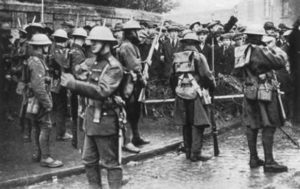
By Thomas Tormey
It is perhaps unsurprising that the death of Elizabeth O’Brien has gone relatively unremarked upon by historians of the Irish revolution. It was Tuesday, 21 June 1921, when Elizabeth, or Bessie as she was known succumbed to wounds incurred in a street ambush the previous Saturday.
As June of 1921 rolled into its fourth week, the War of Independence reached a pivotal point. The preceding days had seen violence, death, and destruction throughout the island of Ireland and the following days would see the opening of the new Northern Ireland parliament by George V.
These days also saw the apex of the urban guerrilla campaign of the IRA’s Dublin Brigade. Bessie was one of many civilian bystanders who became accidental victims of the conflict in Dublin and the tragedy was compounded by the fact that she was the wife of Tom O’Brien, a member of the IRA company that had carried out the ambush.
‘They kept the enemy at bay’: the IRA’s campaign in Dublin
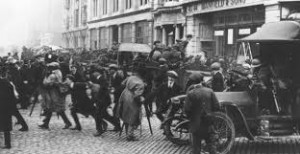
Viewed retrospectively many veterans of the IRA campaign in Dublin felt a perhaps justifiable pride in their actions in 1921. No doubt Dublin republican Simon Donnelly expressed the position of many to the Bureau of Military History:
“The Dublin Brigade and A.S.U. had hundreds of brilliant operations to their credit all during the reign of terror…All honour to the men of the Dublin Brigade: they kept the enemy at bay”.[1]
Writing in 1939, Oscar Traynor, the officer commanding the Dublin Brigade during the most intense part of the conflict echoed those sentiments “The value of the work accomplished in Dublin against the English Forces will, I fear, never be fully realised nor properly estimated during the lifetime of the present generation. It…was possibly one of the most telling factors in compelling English statesmen to sue for peace”.[2]
Although the Dublin Brigade had been heavily involved in the events of Bloody Sunday, 21 November 1920, and isolated incidents had occurred throughout 1920, the urban guerrilla campaign essentially began in January 1921.[3] The campaign was initiated with the formation of the Dublin Brigade’s own ASU. Following on from this, during February and March, the ordinary companies of the Dublin Brigade began to participate in the campaign of street ambushes also.[4]
Dublin Volunteers recognised that their street ambushes inadvertently caused many civilian casualties. Bessie O’Brien was one such victim.
Speaking on a recording made by Irish Folklore Commission on behalf of the Bureau of Military History in the 1950s Traynor described how the campaign involved attacks that were “directed against armed enemy troops travelling in armour plated lorries travelling from place to place in the city” and made use of the element of surprise.[5]
Traynor also asserted that the suddenness of the attacks meant that they were as surprising to the citizens as they were to the Crown forces but that the citizens became expert in the art of taking cover thus leaving Volunteers and the British shooting it out in isolation. This was something of a whitewashing of a much more problematic reality in which civilians were often killed or injured, during IRA ambushes in the city.
Civilian casualties
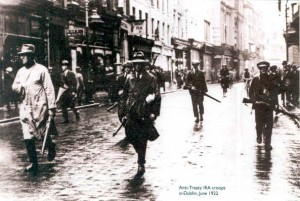
The reminiscences of other Republican veterans highlight the issue. Desmond Ryan, former secretary to the executed 1916 leader Padraig Pearse, and a reporter with the Dublin nationalist daily newspaper The Freeman’s Journal in 1921, summarised the near-daily grind of incidents thus:
Automatically the fingers of the Dublin journalists formed the familiar story: ‘At eight or six or seven o’clock this morning or evening a bomb explosion, followed by a number of shots was heard as a military lorry passed through Blank Street.
The military returned the fire. There were no military casualties. Later a number of civilians were treated, detained, or identified by their relatives at the city hospitals.’[6]
There certainly were military casualties. Ryan may have been taking some literary licence in order to add further pathos to his account, but otherwise he has left a useful summary of the feelings evoked by reading the accounts of those street ambushes in the Freeman. Ernie O’Malley remembered that during his time in Kilmainham jail in 1921 that “every evening when darkness came lorries and tenders were bombed, more civilians were killed than soldiers”.
It is not our purpose to test O’Malley’s assertion here, but his very memory indicated the scale of the problem and carries particular weight since he himself commanded a guerrilla campaign in the city in 1922.[7] One rank-and-file Volunteer, Seán Prendergast, recalled an incident in 1921 during which Oscar Traynor himself, the commander of the Brigade, had been nearly caught in the crossfire, and described how the members of the Dublin Brigade lived with the concern that the fighting in the city streets might lead to an injury of one of their “nearest and dearest”.[8]
Members of the Dublin Brigade lived with the concern that the fighting in the city streets might lead to an injury of one of their “nearest and dearest”
Traynor did recognise that civilian casualties were an issue, as his later reminiscences confirm. Traynor remembered being repeatedly called to explain himself to Cathal Brugha, the republican counter-state’s minister for defence. When interviewed by Ernie O’Malley decades later, Traynor described having to justify a ‘good ambush’ of a British army party in which a female market trader was also killed.
This upset Brugha, who was particularly concerned by female casualties and Traynor described having to issue an order that the Dublin Brigade were not to conduct operations on a Saturday evening because of the number of women who were typically out and about at that time.[9] If this order ever existed there is no evidence that it was adhered to by the Dublin Volunteers.
Ambush on Capel Street
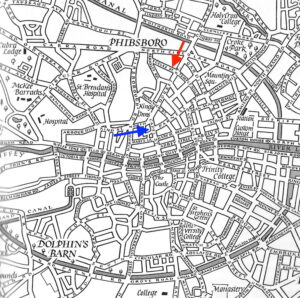
In another, later, recollection, Traynor also described a particularly sad story of how a Volunteer of the 1st Battalion had met with his comrades to conduct an ambush near Capel St, one minute from his place of residence.
Having resisted the temptation to warn his family to stay away from Capel Street, the Volunteer had later arrived home to be met by upset, teary-eyed women who told him that his wife had been killed in the ambush. This was Bessie O’Brien, the wife of Tom O’Brien.[10]
This echoed Seán Prendergast’s remembrance of ‘a very sad fatality’, namely the wife of Tom O’Brien of H Company, 1st Battalion, who was killed in an ambush his own company conducted at the corner of Capel St and King St.[11]
We cannot be absolutely certain that O’Brien was directly involved in the ambush itself. As quartermaster of H Company, he may have just distributed the arms. The Dublin Brigade diary notes only the participation of an NCO and four Volunteers.[12]
Bessie O’Brien was shot four times, probably by British troops, and fatally wounded, in an ambush launched by her husband Tom’s IRA company.
We do know that O’Brien had taken part in the ill-fated raid on Monk’s Bakery after having given Kevin Barry the gun that famously jammed and helped to lead to Barry’s arrest and capture, so his was not always a background role.[13]
The accounts of the incident that caused Bessie’s death vary. Although it is clear that she died of her wounds over seventy-two hours after the ambush. Traynor’s account of weeping, distressed neighbours is not accurate although it may have happened on numerous other occasions in Dublin at that time. The first DMP man on the scene of the ambush on 18 June 1921, Sgt Martin Tuohy, described how he had found Bessie lying wounded at the scene of the ambush.
When she woke up later in hospital she had told him that she had been at the corner of Bolton and Capel Streets when she heard the bombs exploding, she had turned away with a view to seeking refuge at 199 North King Street but was wounded just as she reached the door. This contrasted somewhat with Tom O’Brien’s account. O’Brien stated that his wife had told him that she had heard the explosion and had run out on the street after their son Willie; there she felt a blow in the hip, fell down, and blacked out.
This “blow” was in fact four wounds around the thighs and buttocks. Bessie stabilised in hospital and was later able to talk to people, but slipped away on Tuesday, 21 June, due to an internal haemorrhage. Irrespective of whether Sgt Tuohy’s or Tom O’Brien’s accounts are strictly accurate it seems likely that Bessie’s fatal wounds were caused by gunfire from the party of the Wiltshire Regiment who had been ambushed. The fact that the military court of inquiry was not prepared to blame the IRA is telling.[14]
By contrast the other two people who died in the ambush: twenty-seven year old Kate Mahon of Phibsborough and four-year old Michael Martin of Capel Street, were found to have been murdered by ‘rebels’. Whatever about the terminology used, this was a valid apportionment of blame: both Martin and Mahon were killed by grenade fragments.[15] All accounts agree that the incident began with the explosion of grenades thrown by the IRA before fire was returned by the party of the Wiltshire Regiment who had been in the ambushed lorry.
Funeral and revenge
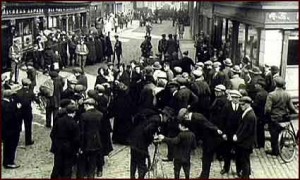
H Company’s ambush on 18 June was the third last such small street ambush in Dublin city. The last street ambush in Dublin also involved a seemingly undeterred H Company and took place a short distance from Capel Street at the corner Dorset Street and North Frederick Street on 24 June, the day of Bessie O’Brien’s funeral at nearby Halston Street.[16]
It is not clear if this ambush was in some way motivated by the events of the previous week. The ambush that led to the death of Bessie O’Brien had been followed twenty-four hours later by the smashing of windows on Capel Street by ‘uniformed men’, a reprisal in other words, and an attack on two British soldiers who were walking down Capel Street by a mob the day after that.[17]
The IRA may have mounted another attack on British troops in revenge for Bessie’s death.
A British Army statement to the press suggested that the ambush party of 24 June had left a public house.[18] Were they members of the funeral party looking for revenge? Although Charles Townshend has suggested that street ambushes were abandoned around this time it is difficult to tell if this was a deliberate policy choice because of the winding down of IRA operations in Dublin as the peace-talks progressed during late June and early July.[19]
While Oscar Traynor may have displayed a reticence about civilian casualties during the War of Independence the attitude of Tom O’Brien is not known. The death notice for Elizabeth recorded his sorrow and that of his children.[20] Even prior to his wife’s death, O’Brien was no stranger to the costs of the War of Independence. He had been one of the IRA party who had broken the news of Kevin Barry’s capture to his mother and sister.[21] Barry’s sister, Kathy, later told Jim O’Donovan that O’Brien had kept the Kevin Barry Memorial Hall and committee going.[22]
Was keeping the memory of his young H Company comrade alive a way for him to channel his personal grief? I cannot say, but I welcome any comments below.
References
[1] Simon Donnelly, BMH w/s 481.
[2] Oscar Traynor, ‘Foreword’, in Dublin Brigade Review (Dublin, 1939), p. 9.
[3] John Dorney, Peace after the final battle (2nd ed., Dublin, 2018 [2014]), p. 208.
[4] Oscar Traynor, BMH w/s 340.
[5] Oscar Traynor voice recording (https://www.militaryarchives.ie/collections/online-collections/bureau-of-military-history-1913-1921/voice-recordings/).
[6] Desmond Ryan, Remembering Sion: a chronicle of storm and quiet (London, 1934), pp 271-2.
[7] John Dorney, The Civil War in Dublin: the fight for the Irish capital (Kildare, 2017), p. 133 & pp 154-6.
[8] Seán Prendergast, w/s 755.
[9] Oscar Traynor interview, UCDA, O’Malley notebooks, P 17b 98.
[10] ‘Statement made by Oscar Traynor TD before his death, the request of Éamon de Valera’, UCDA, Éamon de Valera papers, P 150/3295.
[11] Seán Prendergast, BMH w/s 755.
[12] ‘Dublin Brigade Diary of Operations for June 1921’, UCDA, Mulcahy papers, P7/A/21.
[13] Donal O’Donovan, No more lonely scaffolds: Kevin Barry and his time (Dublin, 1989), p. 81.
[14] ‘Court of Inquiry in Lieu of inquest of Elizabeth O’Brien’, NAUK, WO 35/156, Courts of inquiry in lieu of inquest, Mur-O’Con.
[15] ‘Court of inquiry in lieu of inquest Catherine Mahon’ ‘Court of inquiry in lieu of inquest Michael Martin’, NAUK, WO 35/155A, Courts of inquiry in lieu of inquest, Mad-Mul. See also Eunan O’Halpin, The dead of the Irish revolution p.488 (Yale, 2020).
[16] ‘Dublin Brigade Diary of Operations for June 1921’, UCDA, Mulcahy papers, P7/A/21; ‘Weekly intelligence summary for w/e 26/06/1921’, NAUK, WO 35/91, Dublin District War Diary.
[17] Ibid., and FJ, 20 June, 1921.
[18] FJ, 25 June, 1921.
[19] Charles Townshend, The Republic: the fight for Irish independence (London, 2013), p. 300.
[20] FJ, 23 June 1921.
[21] Séamus Kavanagh, BMH w/s 493.
[22] O’Donovan, No more lonely scaffolds, p. 81.